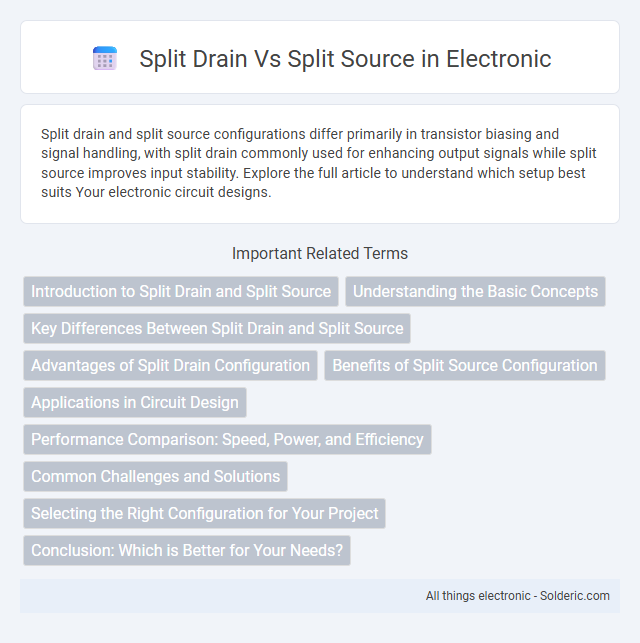Split drain and split source configurations differ primarily in transistor biasing and signal handling, with split drain commonly used for enhancing output signals while split source improves input stability. Explore the full article to understand which setup best suits Your electronic circuit designs.
Comparison Table
| Feature | Split Drain | Split Source |
|---|---|---|
| Definition | Split Drain architecture divides the drain terminal for separate control or routing. | Split Source architecture divides the source terminal for independent control or routing. |
| Application | Used in circuits requiring precise current control and reduced drain capacitance. | Common in designs emphasizing current mirroring and noise reduction at the source. |
| Advantages | Improves switching speed and reduces Miller effect. | Enhances linearity and reduces source inductance effects. |
| Disadvantages | Increased layout complexity and area. | Potentially higher source resistance and layout challenges. |
| Typical Use Cases | High-frequency amplifiers, RF circuits. | Current mirrors, analog multipliers. |
Introduction to Split Drain and Split Source
Split Drain and Split Source refer to specific configurations in transistor amplifier circuits, primarily involving MOSFETs to optimize performance characteristics. The Split Drain design separates the drain terminal into distinct regions to improve current handling and reduce parasitic capacitances, enhancing frequency response and power efficiency. Understanding these configurations helps you select the appropriate transistor setup for your application's speed and power requirements.
Understanding the Basic Concepts
Split drain and split source configurations are fundamental methods in transistor circuit design, each influencing current flow and voltage behavior differently. Split drain refers to dividing the drain terminal to manage output currents separately, commonly enhancing load balancing in analog circuits. Split source involves dividing the source terminal to control current input paths, providing finer control over transistor operation and improving signal integrity in amplification stages.
Key Differences Between Split Drain and Split Source
Split Drain and Split Source configurations differ primarily in their voltage gain and input impedance characteristics in transistor amplifier circuits. Split Drain often provides higher voltage gain by sharing the load between two transistors, while Split Source typically offers improved linearity and input impedance by splitting the current path. Understanding these key differences helps optimize Your circuit design for either voltage amplification or signal fidelity.
Advantages of Split Drain Configuration
A Split Drain configuration offers improved heat dissipation by separating the drain terminals, reducing thermal coupling and enhancing device reliability in high-power applications. This layout minimizes electrical interference and crosstalk between adjacent components, leading to better signal integrity and performance stability. Enhanced current handling capacity and simplified circuit design also contribute to its widespread adoption in power electronics and RF devices.
Benefits of Split Source Configuration
Split Source configurations offer improved circuit stability by reducing the Miller effect, which enhances high-frequency performance in analog designs. This setup provides better voltage gain and linearity, making it ideal for RF amplifiers and low-noise applications. Your circuitry benefits from lower input capacitance and increased bandwidth, optimizing overall signal integrity.
Applications in Circuit Design
Split drain and split source configurations serve different purposes in circuit design; split drain is often used for improving voltage swing and driving capability in output stages, while split source is preferred for precise control of current flow in analog circuits. Your choice between these topologies depends on whether you prioritize output drive strength or input modulation accuracy, influencing the performance of amplifiers, mixers, and other signal processing components. Optimizing split drain for high-speed digital outputs contrasts with split source preference in current mirrors and transconductance amplifiers aimed at linearity and noise reduction.
Performance Comparison: Speed, Power, and Efficiency
Split drain transistors typically offer faster switching speeds due to reduced parasitic capacitance, enhancing overall circuit performance. In contrast, split source designs provide improved power efficiency by minimizing leakage currents and enabling better control over current flow. Efficiency in integrated circuits often favors split source configurations for low-power applications, while split drain is preferred in high-speed environments.
Common Challenges and Solutions
Split drain and split source configurations commonly face challenges related to impedance matching and heat dissipation, which can affect overall circuit performance. Designers optimize these aspects by carefully selecting transistor sizes and biasing conditions to ensure stability and minimize noise. Your ability to implement precise layout techniques and thermal management solutions directly improves the efficiency and reliability of split drain versus split source circuits.
Selecting the Right Configuration for Your Project
Selecting the right configuration between split drain and split source depends heavily on circuit requirements such as voltage gain, input/output impedance, and noise performance. Split drain configurations offer better high-frequency response and are ideal for applications requiring higher output voltage swing, while split source setups provide improved linearity and lower distortion, making them suitable for analog amplifiers. Evaluating these factors ensures your design maximizes efficiency and performance tailored to your specific project needs.
Conclusion: Which is Better for Your Needs?
Split Drain and Split Source configurations each offer unique advantages depending on your circuit requirements, with Split Drain excelling in power efficiency and Split Source providing superior noise immunity. Your choice hinges on factors such as load characteristics, signal integrity demands, and power constraints. Evaluating these parameters ensures optimal performance tailored to your specific application needs.
Split Drain vs Split Source Infographic

 solderic.com
solderic.com